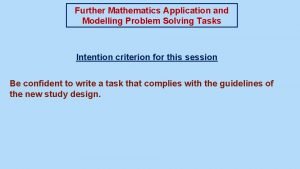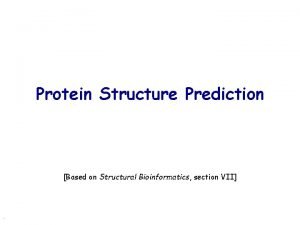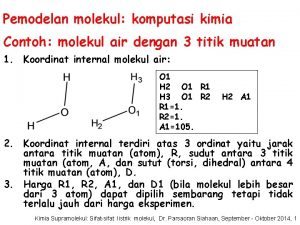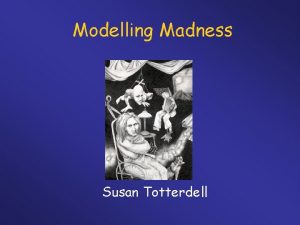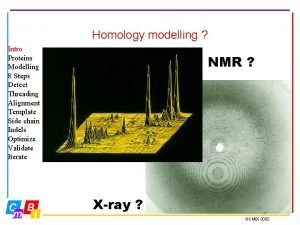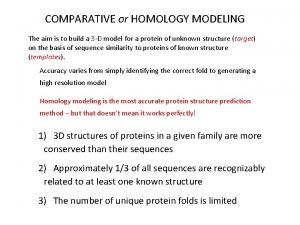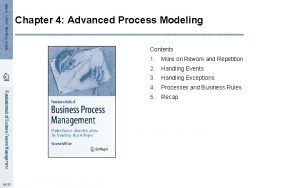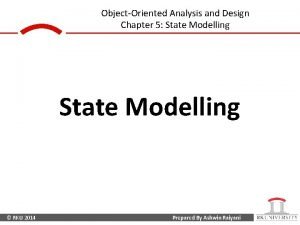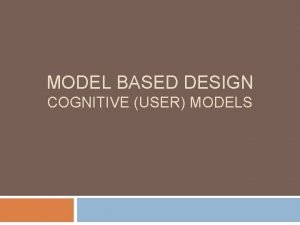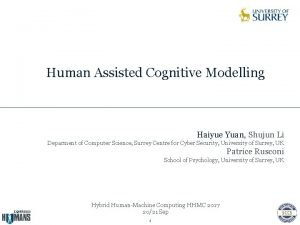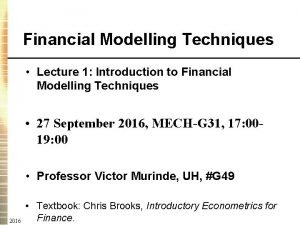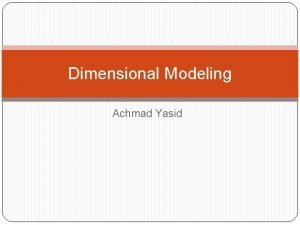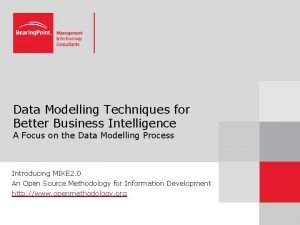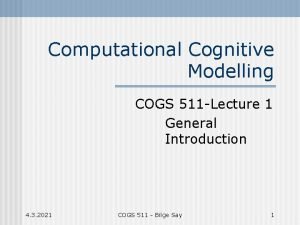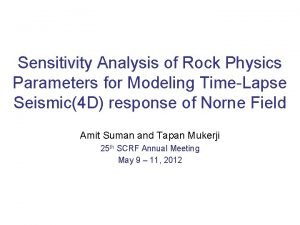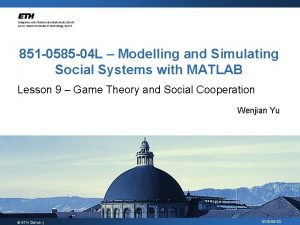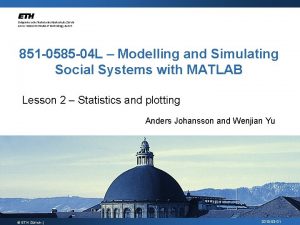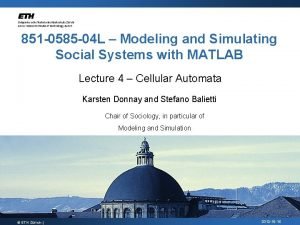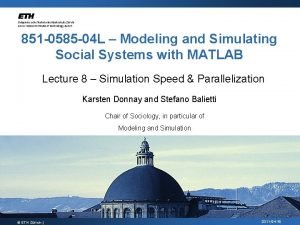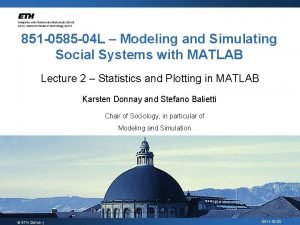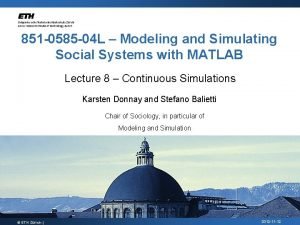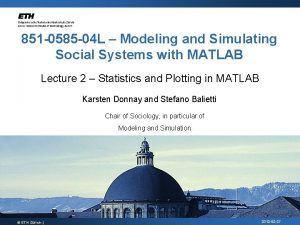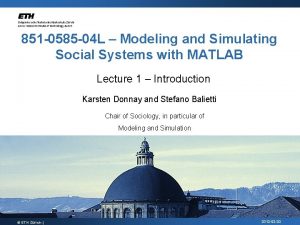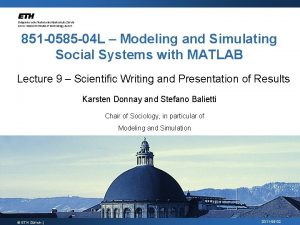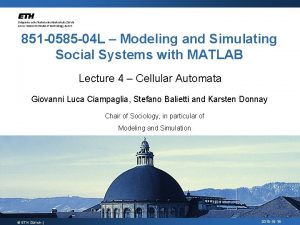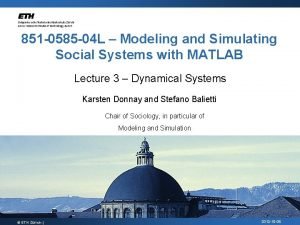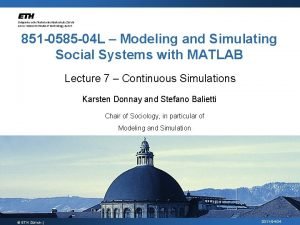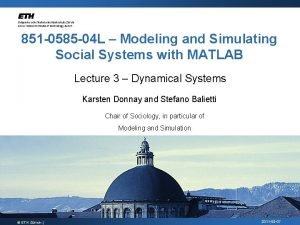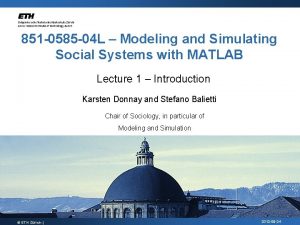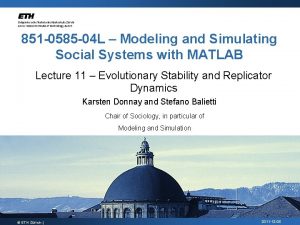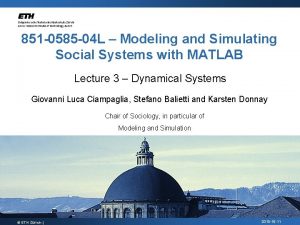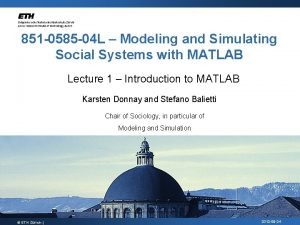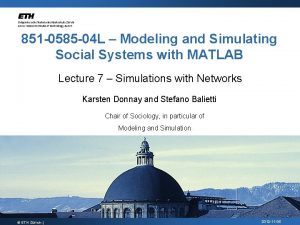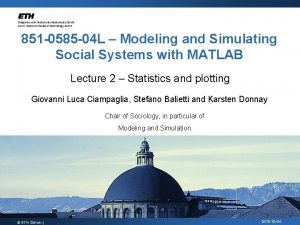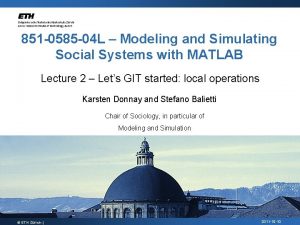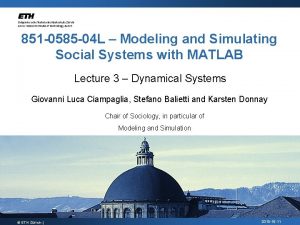851 0585 04 L Modelling and Simulating Social










































- Slides: 42

851 -0585 -04 L – Modelling and Simulating Social Systems with MATLAB Lesson 3 – Dynamical Systems Anders Johansson and Wenjian Yu © ETH Zürich | 2010 -03 -08

Projects § Implementation of a model from the Social -Science literature in MATLAB. § Carried out in pairs. § The projects will be assigned next week: March 15, 2010 -03 -08 A. Johansson & W. Yu / andersj@ethz. ch yuwen@ethz. ch 2

Lesson 3 - Contents § Differential Equations § Dynamical Systems Pendulum § Lorenz attractor § Lotka-Volterra equations § Epidemics: Kermack-Mc. Kendrick model § § Exercises 2010 -03 -08 A. Johansson & W. Yu / andersj@ethz. ch yuwen@ethz. ch 3

Differential equations § Solving differential equations numerically can be done by a number of schemes. The easiest way is by the 1 st order Euler’s Method: x x(t) x(t-Δt) t Δt 2010 -03 -08 A. Johansson & W. Yu / andersj@ethz. ch yuwen@ethz. ch 4

Dynamical systems § A dynamical system is a mathematical description of the time dependence of a point in a space. § A dynamical system is described by a set of linear/non-linear differential equations. § Even though an analytical treatment of dynamical systems is often complicated, obtaining a numerical solution is straight forward. 2010 -03 -08 A. Johansson & W. Yu / andersj@ethz. ch yuwen@ethz. ch 5

Pendulum § A pendulum is a simple dynamical system: L = length of pendulum (m) ϴ = angle of pendulum g = acceleration due to gravity (m/s 2) The motion is described by: 2010 -03 -08 A. Johansson & W. Yu / andersj@ethz. ch yuwen@ethz. ch 6

Pendulum: MATLAB code 2010 -03 -08 A. Johansson & W. Yu / andersj@ethz. ch yuwen@ethz. ch 7

Set time step 2010 -03 -08 A. Johansson & W. Yu / andersj@ethz. ch yuwen@ethz. ch 8

Set constants 2010 -03 -08 A. Johansson & W. Yu / andersj@ethz. ch yuwen@ethz. ch 9

Set starting point of pendulum 2010 -03 -08 A. Johansson & W. Yu / andersj@ethz. ch yuwen@ethz. ch 10

Time loop: Simulate the pendulum 2010 -03 -08 A. Johansson & W. Yu / andersj@ethz. ch yuwen@ethz. ch 11

Perform 1 st order Euler’s method 2010 -03 -08 A. Johansson & W. Yu / andersj@ethz. ch yuwen@ethz. ch 12

Plot pendulum 2010 -03 -08 A. Johansson & W. Yu / andersj@ethz. ch yuwen@ethz. ch 13

Set limits of window 2010 -03 -08 A. Johansson & W. Yu / andersj@ethz. ch yuwen@ethz. ch 14

Make a 10 ms pause 2010 -03 -08 A. Johansson & W. Yu / andersj@ethz. ch yuwen@ethz. ch 15

Pendulum: Executing MATLAB code 2010 -03 -08 A. Johansson & W. Yu / andersj@ethz. ch yuwen@ethz. ch 16

Lorenz attractor § The Lorenz attractor defines a 3 -dimensional trajectory by the differential equations: § σ, r, b are parameters. 2010 -03 -08 A. Johansson & W. Yu / andersj@ethz. ch yuwen@ethz. ch 17

Lorenz attractor: MATLAB code 2010 -03 -08 A. Johansson & W. Yu / andersj@ethz. ch yuwen@ethz. ch 18

Set time step 2010 -03 -08 A. Johansson & W. Yu / andersj@ethz. ch yuwen@ethz. ch 19

Set number of iterations 2010 -03 -08 A. Johansson & W. Yu / andersj@ethz. ch yuwen@ethz. ch 20

Set initial values 2010 -03 -08 A. Johansson & W. Yu / andersj@ethz. ch yuwen@ethz. ch 21

Set parameters 2010 -03 -08 A. Johansson & W. Yu / andersj@ethz. ch yuwen@ethz. ch 22

Solve the Lorenz-attractor equations 2010 -03 -08 A. Johansson & W. Yu / andersj@ethz. ch yuwen@ethz. ch 23

Compute gradient 2010 -03 -08 A. Johansson & W. Yu / andersj@ethz. ch yuwen@ethz. ch 24

Perform 1 st order Euler’s method 2010 -03 -08 A. Johansson & W. Yu / andersj@ethz. ch yuwen@ethz. ch 25

Update time 2010 -03 -08 A. Johansson & W. Yu / andersj@ethz. ch yuwen@ethz. ch 26

Plot the results 2010 -03 -08 A. Johansson & W. Yu / andersj@ethz. ch yuwen@ethz. ch 27

Animation 2010 -03 -08 A. Johansson & W. Yu / andersj@ethz. ch yuwen@ethz. ch 28

2010 -03 -08 A. Johansson & W. Yu / andersj@ethz. ch yuwen@ethz. ch 29

Food chain 2010 -03 -08 A. Johansson & W. Yu / andersj@ethz. ch yuwen@ethz. ch 30

Lotka-Volterra equations § The Lotka-Volterra equations describe the interaction between two species, prey vs. predators, e. g. rabbits vs. foxes. x: number of prey y: number of predators α, β, γ, δ: parameters 2010 -03 -08 A. Johansson & W. Yu / andersj@ethz. ch yuwen@ethz. ch 31

Lotka-Volterra equations § The Lotka-Volterra equations describe the interaction between two species, prey vs. predators, e. g. rabbits vs. foxes. 2010 -03 -08 A. Johansson & W. Yu / andersj@ethz. ch yuwen@ethz. ch 32

Lotka-Volterra equations § The Lotka-Volterra equations describe the interaction between two species, prey vs. predators, e. g. rabbits vs. foxes. 2010 -03 -08 A. Johansson & W. Yu / andersj@ethz. ch yuwen@ethz. ch 33

Epidemics Source: Balcan, et al. 2009 2010 -03 -08 A. Johansson & W. Yu / andersj@ethz. ch yuwen@ethz. ch 34

SIR model § A model for epidemics is the SIR model, which describes the interaction between Susceptible, Infected and Removed (immune) persons, for a given disease. 2010 -03 -08 A. Johansson & W. Yu / andersj@ethz. ch yuwen@ethz. ch 35

Kermack-Mc. Kendrick model § of diseases like the plague and cholera. A popular SIR model is the Kermack-Mc. Kendrick model. The model was proposed for explaining the spreading § The model assumes: A constant population size. § A zero incubation period. § The duration of infectivity is as long as the duration of the clinical disease. § 2010 -03 -08 A. Johansson & W. Yu / andersj@ethz. ch yuwen@ethz. ch 36

Kermack-Mc. Kendrick model § The Kermack-Mc. Kendrick model is specified as: S: Susceptible persons I: Infected persons R: Removed (immune) persons β: Infection rate γ: Immunity rate 2010 -03 -08 S β transmission R γ recovery A. Johansson & W. Yu / andersj@ethz. ch yuwen@ethz. ch I 37

Kermack-Mc. Kendrick model § The Kermack-Mc. Kendrick model is specified as: S: Susceptible persons I: Infected persons R: Removed (immune) persons β: Infection rate γ: Immunity rate 2010 -03 -08 A. Johansson & W. Yu / andersj@ethz. ch yuwen@ethz. ch 38

Kermack-Mc. Kendrick model § The Kermack-Mc. Kendrick model is specified as: S: Susceptible persons I: Infected persons R: Removed (immune) persons β: Infection rate γ: Immunity rate 2010 -03 -08 A. Johansson & W. Yu / andersj@ethz. ch yuwen@ethz. ch 39

Exercise 1 § Implement and simulate the Kermack. Mc. Kendrick model in MATLAB. Use the starting values: S=I=500, R=0, β=0. 0001, γ =0. 01 § Slides/exercises: www. soms. ethz. ch/matlab (Download only possible with Firefox!) 2010 -03 -08 A. Johansson & W. Yu / andersj@ethz. ch yuwen@ethz. ch 40

Exercise 2 § A key parameter for the Kermack-Mc. Kendrick model is the epidemiological threshold, βS/γ. Plot the time evolution of the model and investigate the influence of the epidemiological threshold, in particular the cases: 1. 2. βS/γ < 1 βS/γ > 1 Starting values: S=I=500, R=0, β=0. 0001 2010 -03 -08 A. Johansson & W. Yu / andersj@ethz. ch yuwen@ethz. ch 41

Exercise 3 - optional § Implement the Lotka-Volterra model and investigate the influence of the timestep, dt. § How small must the timestep be in order for the 1 st order Eulter‘s method to give reasonable accuracy? § Check in the MATLAB help how the functions ode 23, ode 45 etc, can be used for solving differential equations. 2010 -03 -08 A. Johansson & W. Yu / andersj@ethz. ch yuwen@ethz. ch 42
 Heat stiffening and cold stiffening
Heat stiffening and cold stiffening Conditions simulating rigor mortis
Conditions simulating rigor mortis 10 cfr 851
10 cfr 851 Regulation 851
Regulation 851 Place value drawing
Place value drawing 888-781-0585
888-781-0585 Ngic 888-781-0585
Ngic 888-781-0585 Advantages of wireframe modelling
Advantages of wireframe modelling Modelling relationships and trends in data
Modelling relationships and trends in data Problem solving and modelling task example
Problem solving and modelling task example Social thinking and social influence
Social thinking and social influence Social thinking social influence social relations
Social thinking social influence social relations What is technological modelling
What is technological modelling Energy based model
Energy based model Jsimgraph
Jsimgraph Molecular modelling laboratory
Molecular modelling laboratory Modelling madness
Modelling madness Modeling rich interaction in hci
Modeling rich interaction in hci Private equity lbo case study
Private equity lbo case study Homology modelling steps
Homology modelling steps Hair modelling
Hair modelling Explain embedded product development life cycle
Explain embedded product development life cycle Homology modelling steps
Homology modelling steps Exercise 4
Exercise 4 Mathematical modeling of electrical systems
Mathematical modeling of electrical systems Modeling rich interaction in hci
Modeling rich interaction in hci Unit 5 data modelling assignment 2
Unit 5 data modelling assignment 2 Structured analysis example
Structured analysis example Algorithmic cost modelling
Algorithmic cost modelling Class responsibility collaborator modelling
Class responsibility collaborator modelling State modelling
State modelling Object oriented model adalah
Object oriented model adalah Multi-jet modeling
Multi-jet modeling An introduction to model-based cognitive neuroscience
An introduction to model-based cognitive neuroscience Cognitive modelling
Cognitive modelling Financial modelling techniques
Financial modelling techniques Tujuan dari dimensional modelling
Tujuan dari dimensional modelling Data modelling techniques in business intelligence
Data modelling techniques in business intelligence Malatesta's modelling e.g. by mother
Malatesta's modelling e.g. by mother Cognitive modelling
Cognitive modelling Bim introduction ppt
Bim introduction ppt Web application threat modeling
Web application threat modeling 150000/175
150000/175









